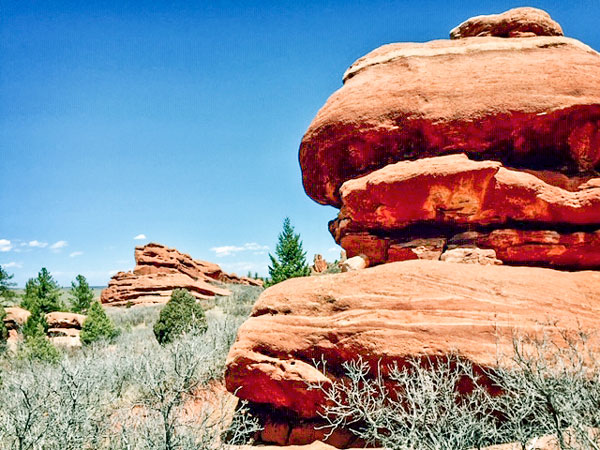Perry Park: The essence of Douglas County part I
Article and photo by Joe Gschwendtner; information sourced from Fading Past: The Story of Douglas County, Colorado by Susan Consola Appleby

Perry Park
Periodically we golf at Perry Park. When on the course, it is impossible not to be drawn into the sheer, raw beauty of the place. Like Roxborough Park, this tucked-away enclave captures true Colorado with fresh air and red rock formations, sculpted by God Himself, placed among the thick stands of pine and scrub oak. It offers idyllic peace and majesty far from the maddening crowd. Perry Park’s history as a community though, is more nuanced.
Naturally, Native Americans were the first to inhabit this land; to them it was spiritual. Their stories tell of powerful gods carving out the rock formations. Buckskin-clad pioneers would follow. Then, Frederick Hayden passed through on his 1869 geological expedition. He named it Pleasant Park.
Railroad baron John Dietz Perry first recognized the potential of Perry Park’s rapture. In reconnoitering the area for rail service between Kansas City and Denver, his eyes were opened to the possibilities of life on West Plum Creek. In 1872, armed with money and vision, he fashioned his own family ranch community of 4,000 acres, naming it Perry Park Ranch. His son, Charles Perry, was its general manager until his death in 1876 when he died after being kicked by a horse.
Simultaneously, the ranch and surrounds came to be called Pleasant Park and was visited by day tourists from Denver and Colorado Springs via stage from the Larkspur railroad station (the stage stop was at the tee box on the second hole). One notable visitor was the bold English woman and author, Isabella Bird. In her book A Ladies Life in the Rocky Mountains, she recounts the narrow canyons as “gloomily magnificent,” the rocks as “monumental” and 50 to 300 feet in height, bright vermilion, green, buff and orange.
Perry would occasionally visit the ranch, but his plans changed. In August 1879, he advertised his holdings for sale in the Rocky Mountain News. When it didn’t sell, he promoted and operated the property as an upscale summer resort for tourists. Unfortunately, after a decade of fits and starts and under absentee ownership, the concept languished. One article in the Castle Rock Journal of 1882 sharply skewered him for the incompetence of management during a July 4th event.
In 1888, Perry finally sold the bulk of his holdings to the Red Stone Land and Mining Company, retaining only a minority stock position. Another railroad titan, Bela Hughes, president of the Denver Pacific Railway, took on chief executive responsibilities. Both recognized that the resort concept had another shortcoming – location. In spite of its captivating charm, its remoteness made the journey a stretch for all but the well-heeled. The solution – another railroad.
After a survey was initiated for the tracks planned from Sedalia to Palmer Lake through Perry Park, Bear Creek was dammed up. Voila! Lake Wauconda was born and would be the future focal point of a grandiose village featuring sculpture, chapel, casino, and library. None other than famed landscape designer Frederick Law Olmstead predicted its success, so long as the natural character of the area was not violated.
